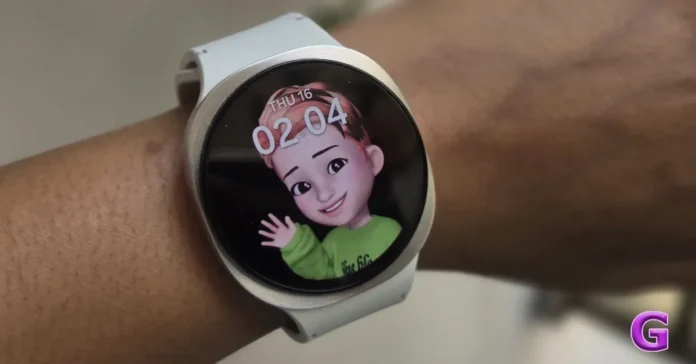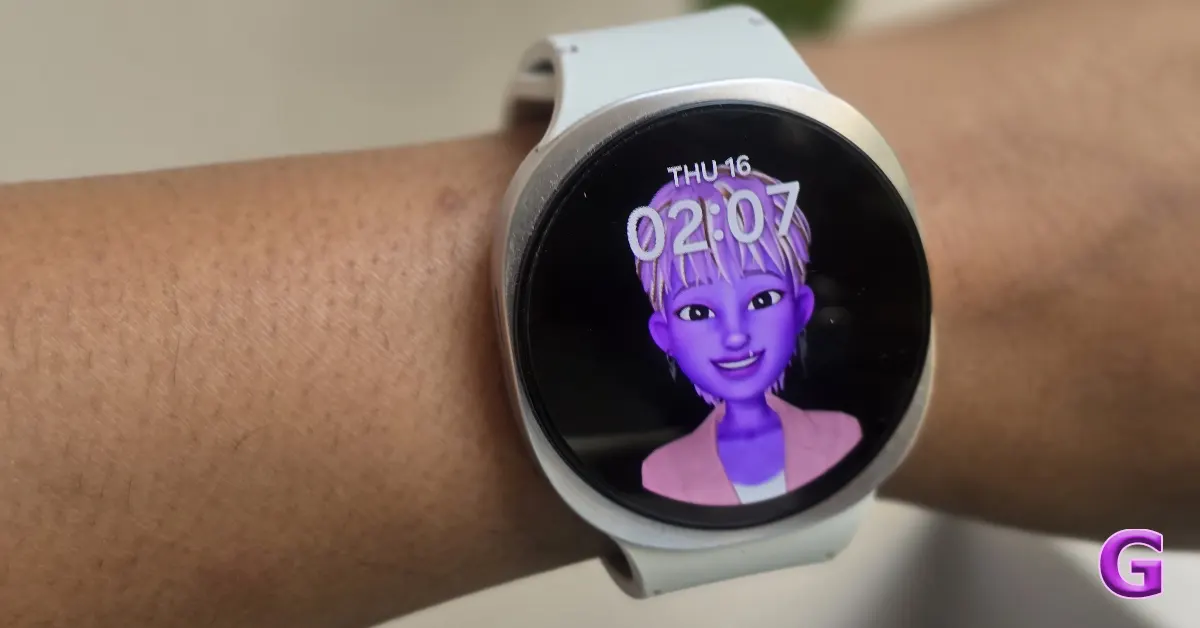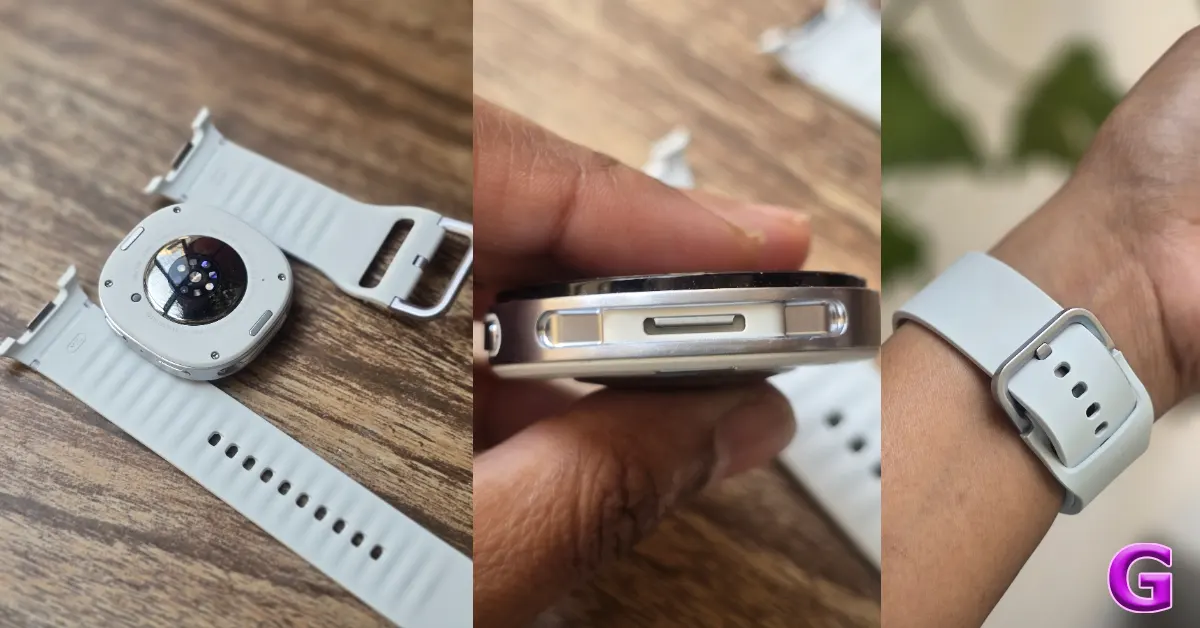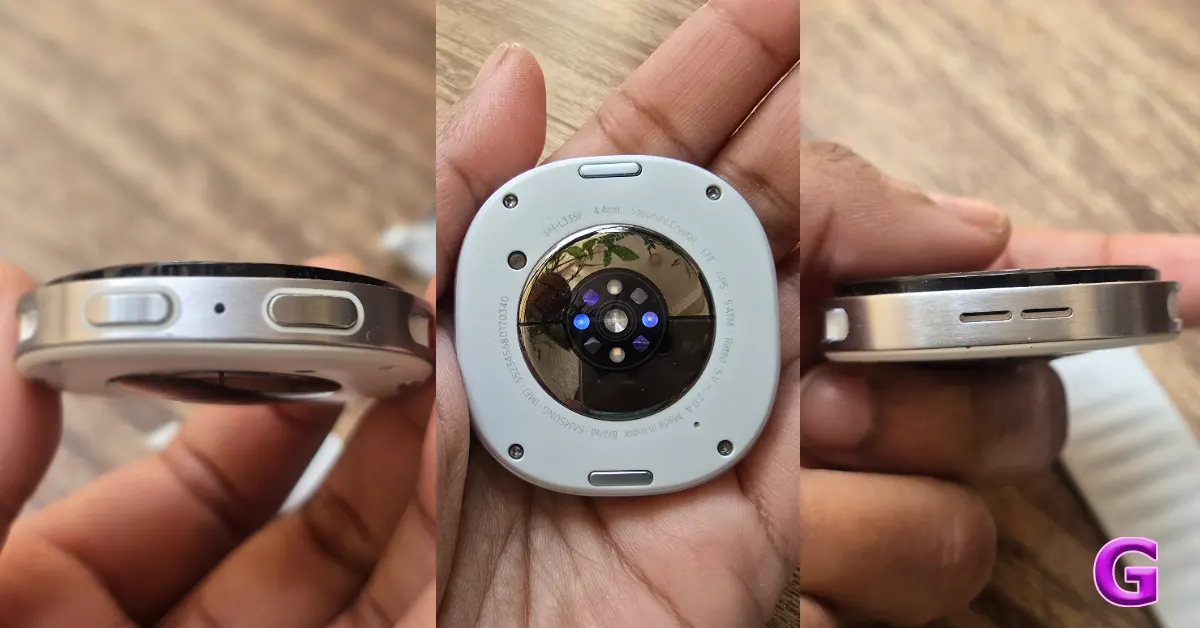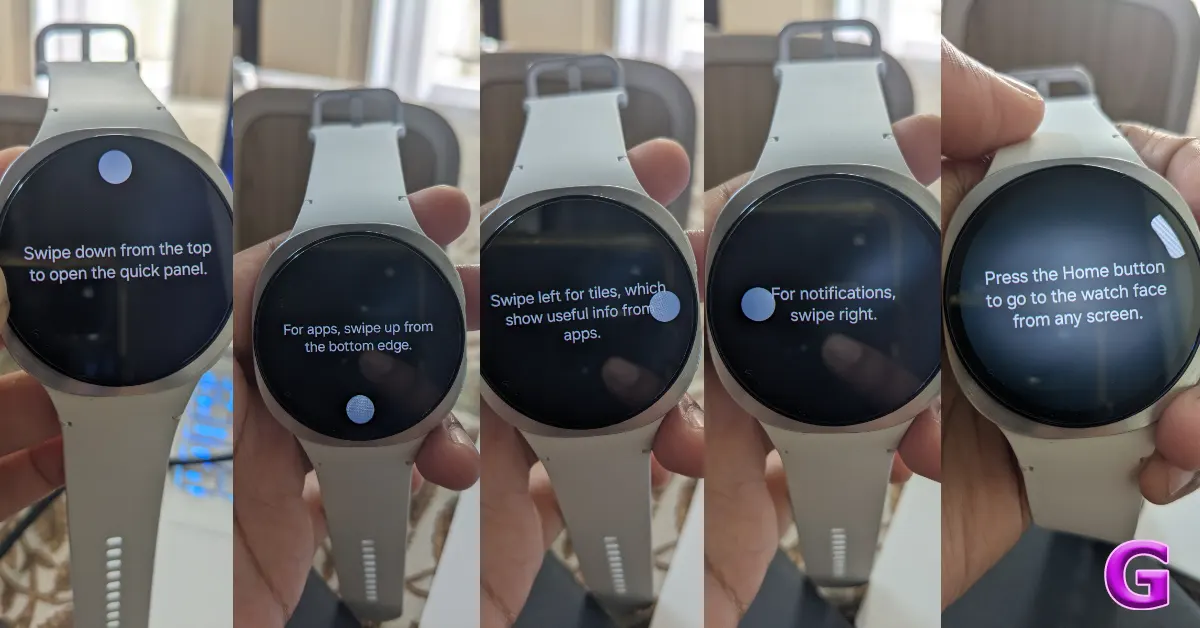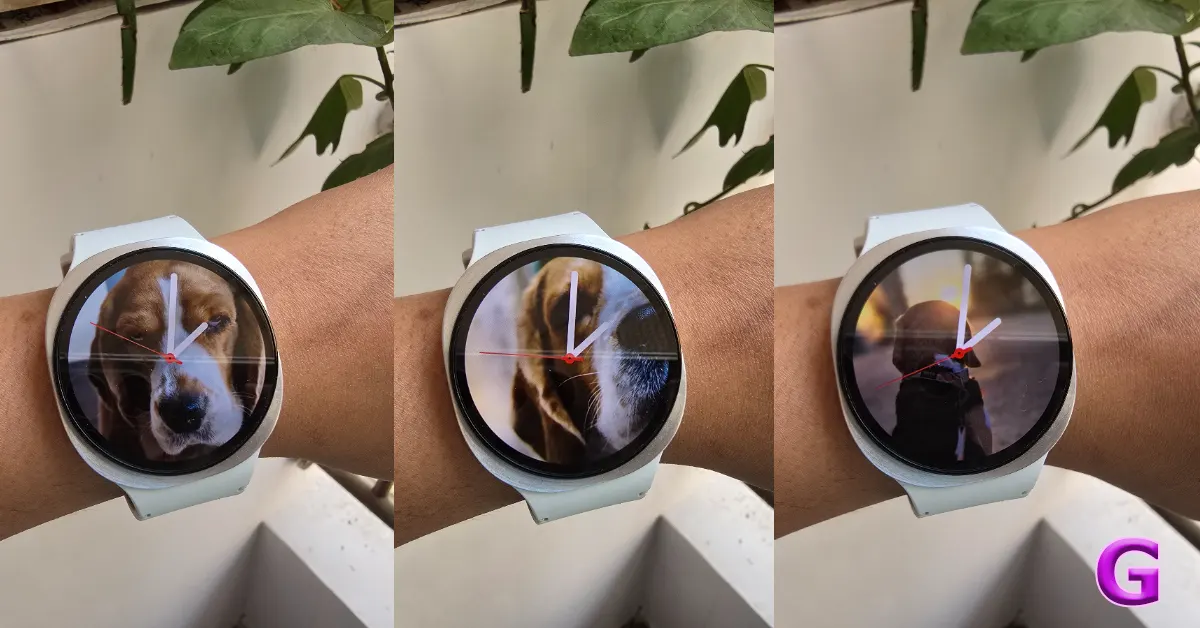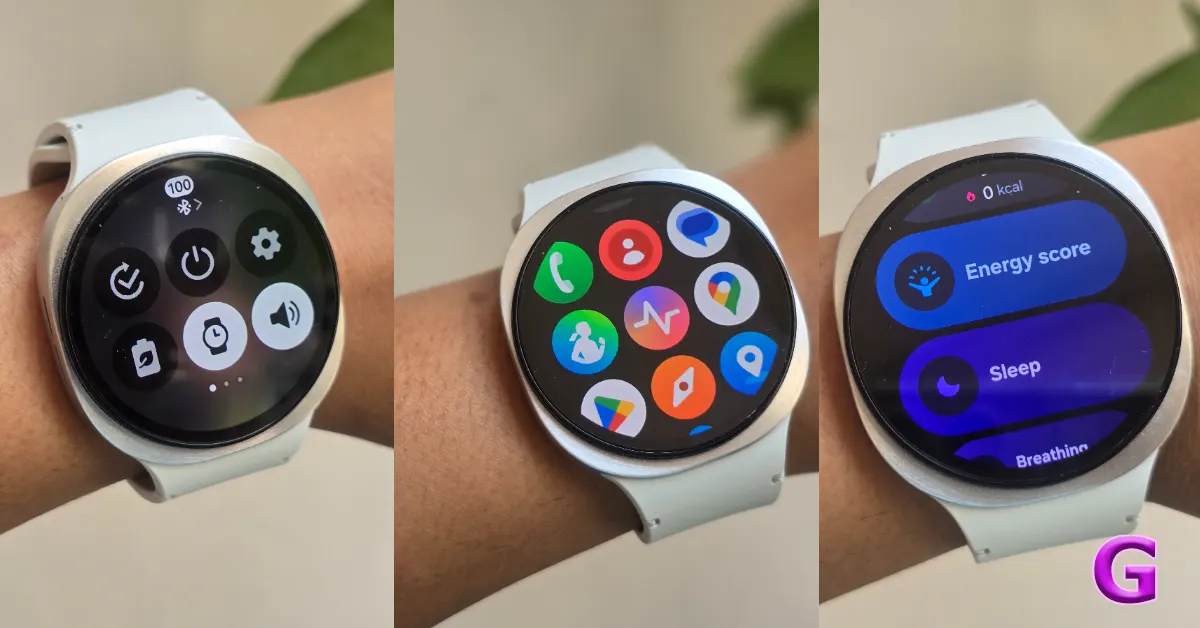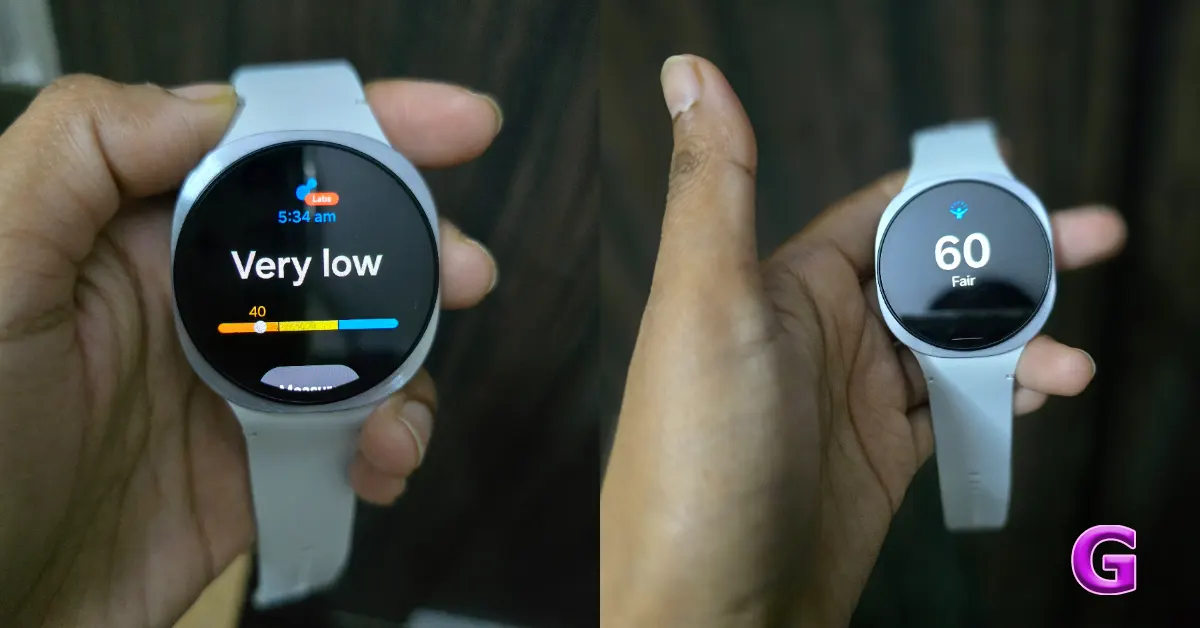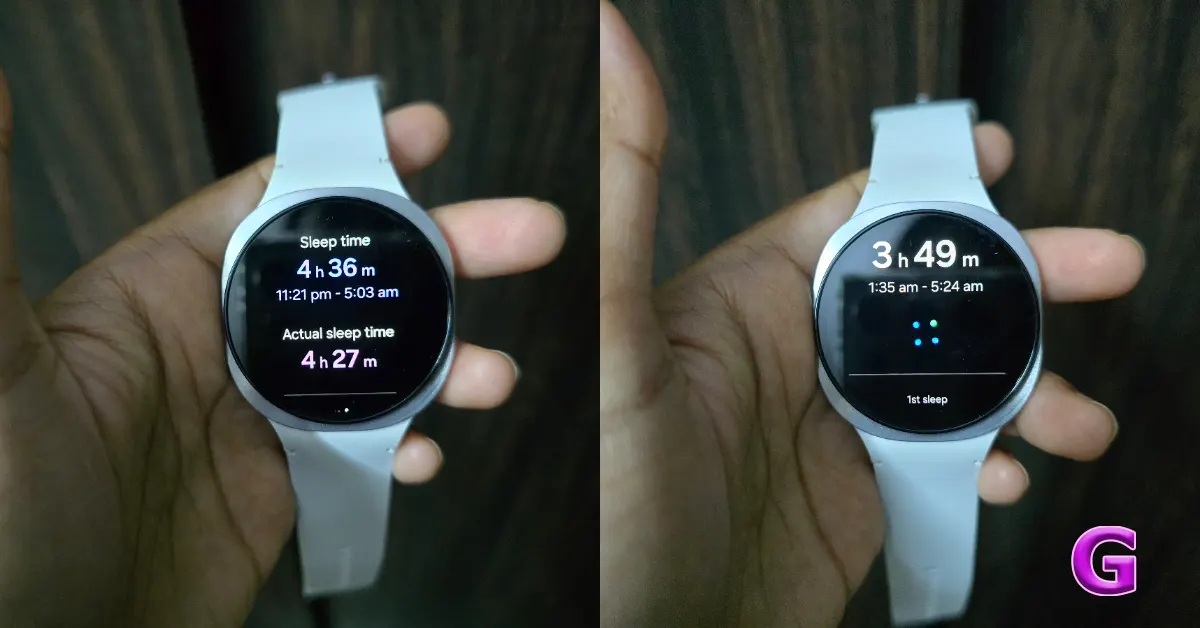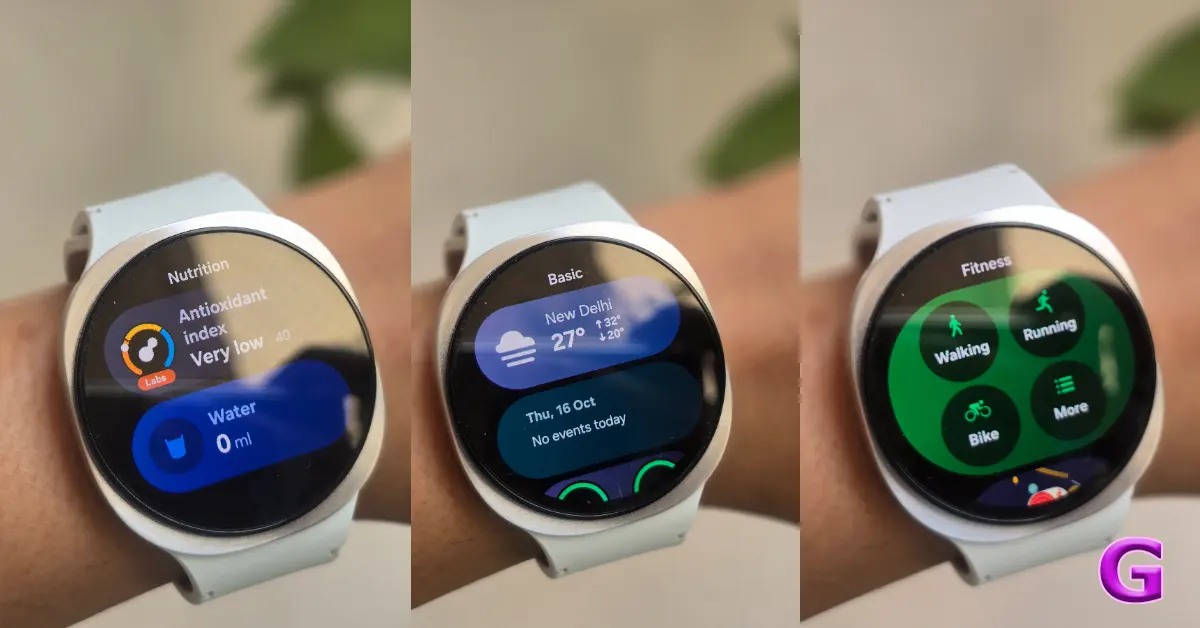This year, Samsung released two new smartwatches. The Galaxy Watch 8 and the more premium Galaxy Watch 8 Classic. Small but significant improvements are included with the wearable, and the focus of this review is the Watch 8. It’s been our everyday companion for a very long time; it’s attractive, enjoyable to use, and has a ton of fitness and health functions. Of course, Gemini is now on board, making the Galaxy Watch 8 series the first smartwatches to ship with native compatibility for Google’s AI assistant.
In This Article
Design
As discussed previously, the Samsung Galaxy Watch 8 has become a key part of daily use. In terms of construction, the Watch 8 series retains a similar design to its predecessor, the Watch 7. The Watch 8, which comes in two sizes (40 mm and 44 mm), is made of aluminium and has a sapphire glass coating that improves its resistance to scratches and other small dings. Military certification, which guarantees it can withstand severe weather conditions, adds even more credence to its endurance. It also features an IP68 classification, indicating strong resistance to water and dust. This means that you may wear it in the shower or swim without worrying about it becoming damaged.
The most recent design revisions to the Watch 8 series prioritise user comfort and aesthetics. The wristband now comfortably wraps around the wrist, reducing discomfort caused by the outward arch at the buckle point in earlier models. This enhancement improves the overall experience by making it easier to take off and clip back the band. The silicone strap wraps around the wrist for a pleasant, snug fit. Even while sweating profusely during a workout, the strap does not feel uncomfortable.
The Watch 8 series’ uniform squircle design creates a distinct and visually appealing brand image. Furthermore, the new design is distinguished by its lightweight and small appearance, making it the lightest Galaxy Watch ever manufactured by Samsung. This mix of comfort and design distinguishes the Galaxy Watch 8 series as one of the most comfortable smartwatches on the market.
The new Galaxy Watch features a very slim design, weighing approximately 30 grams and measuring 8.6 mm in thickness. This signifies an enormous improvement in the device’s sleekness. Concerns may emerge concerning its battery life, but more information on this will be provided later in the review.
However, one design difference that we enjoyed is that the watch has replaced the classic 20 mm spring pin connector with a new dynamic lug system. With this new mechanism, you may now press a button on the watch. So, all you have to do is push it, and the new strap will detach immediately. The strap’s two buttons make it easy to disconnect from the dial. And it is surely easier than the previous way.
There are a couple of band options available as well. First, there’s a hybrid band with a leather-like texture that comes in five different colours. This is complemented with a sport band in a variety of colours, suitable for a more athletic or casual style. In addition, there is a fabric band with a new and appealing pattern, which is great for people looking for a more trendy choice. Finally, the athleisure band is offered, which is distinguished by its earthy tones and combines usefulness with a stylish look appropriate for a variety of events. Overall, the selection of bands offers alternatives that combine functionality with aesthetic appeal.
The Galaxy Watch 8 series boasts Super AMOLED screens with a pixel density of 327 ppi and a peak brightness of 3,000 nits, which matches the previous year’s Galaxy Watch Ultra and represents a 50% improvement in brightness.
The standard Galaxy Watch 8 has a 1.34-inch screen with a resolution of 438×438 pixels, and the 44 mm variant has a bigger 1.47-inch display with a resolution of 480×480 pixels. The overall screen quality is excellent, with no issues identified with brightness, sharpness, viewing angles, or colour accuracy.
Many users prefer keeping their watches at full brightness; however, this is unnecessary because these watches can attain an astounding peak brightness of 3,000 nits, which is more than enough for visibility in both outdoor and indoor settings. Additionally, the touch response functionality is exceptional.
Also read: Samsung Galaxy Watch8 Classic Review: Impressive across the board
When you flip the watch around, you’ll discover that Samsung has stayed with health monitoring sensors, notably a heart rate sensor, SpO2 sensor, and temperature sensor. Furthermore, the gadget has a wireless charger that magnetically attaches to the watch’s bottom panel for easy charging.
On the right side of the device’s frame, two customizable physical buttons are present, flanking a microphone. These buttons can be configured through the Wearable app. The top button serves as a shortcut to the home screen, while the bottom button allows users to return to the previous screen. Meanwhile, the left side of the frame features a small speaker. Additionally, the buttons are integrated with BioActive Sensors, enhancing their functionality.
As mentioned before, the watch has sapphire crystal glass protection, which is very useful for those who are susceptible to unintentional impacts. And you know how clumsy we are? We have a habit of hitting our hands on hard and sharp objects when walking around.
During a recent rickshaw ride, we accidentally slammed our hand against the vehicle’s metal body but were relieved to discover no damage to the watch, not even a scratch. This resilience emphasises the durability of these watches, which also carry the military standard 810H certification, confirming their toughness in a variety of settings.
Performance
Samsung’s Galaxy Watch 8 series is powered by the Exynos W1000 processor, which increases processing speed and efficiency. This model in the series has 32GB of storage and 2GB of RAM, resulting in quicker responses for tasks and voice commands while also boosting power efficiency.
The Samsung watch comes with the newest OneUI 8 interface, which is based on Google’s Wear OS 6. This integration provides users with access to a variety of apps available on the Google Play Store, specifically designed for watch installation. The watch’s functionality is brought out by its smooth interface and rich features, which offer a flexible user experience.
The new edition, while functionally comparable to its predecessor, adds various aesthetic improvements, such as pill-shaped widgets and a Now Bar reminiscent of those found on smartphones. A key improvement is that each swipe now takes you to a page with customizable multi-information tiles and real-time updates. Users will encounter no latency, making the UI exceptionally snappy and responsive. This responsiveness is due to the implementation of the latest 3 nm Exynos W1000 processor, which improves overall performance and user experience.
So we have a health page that contains all health-related tiles. Then we have a fitness page with fitness-related content and a basic one with some extras. And, people, each of them is fully customizable. So, you could open the app, navigate to the tiles area, and view all of these pages. Now, inside Health, we can add more tiles, as that may be health-related or from another app on your watch. You may also rearrange the tiles and change the label from “health” to anything you wish, such as “fitness.”
A nice new feature that is now only available with the Galaxy Watch 8 series is that you always have an AI assistant on your wrist. And all you have to do is say, “Hey Google,” and it activates Google Gemini. And now, you may ask it anything. So Gemini connects with Google Search and returns the results. You don’t have to end there. You may then do this. We can instruct it to send a message to someone on WhatsApp. Gemini will interact with the WhatsApp app on your phone and send the results as a message without you having to pick up the phone. Pretty awesome.
Gemini, an integration tool, enhances productivity by allowing users to easily start timers and stopwatches or add reminders to their calendars through Samsung’s native Reminder app. This functionality extends across many of Samsung’s native applications, including music apps, Google Maps, Google Tasks, and Google Search, facilitating seamless interactions and efficient task management.
Of course, you also receive several new watch faces, and some of them are extremely fantastic. So there’s analogue, animated, and digital. Users may access these by opening the wearables app on their smartphones and heading to the watch faces section, where they can choose from a large selection.
One interesting feature is the capability to personalise the Photos watch face. Users can upload an animated GIF from their gallery by selecting a backdrop and hitting the Add icon. Users may also pick numerous GIFs, which makes the personalisation process more dynamic. After selecting the GIFs, users may further customise the watch face by customising the clock and adding complications, which improves functionality and customisation.
Click the “Save” option. Hello, you now have an animated watch face. And it looks great. And, because you picked numerous photographs, tapping on the watch face will quickly change the way it looks. So you can get some really crazy-looking watch faces.
Okay, but if animation isn’t your thing, you’ve got to try this. Tap and hold, then slide to the right, choose the + symbol, and locate the Heritage Classic watch face. Then you may hit customise.
And there are a lot of other options to experiment with. But first, make sure you go to the low-light mode option and set it to auto. Then go to the background portion and swipe up. Because, again, this watch face allows you to pick a custom picture. But here is the actual twist. Choose an option that includes a pretty fantastic phrase or inspiring quotation. Because, after that’s done, look how awesome this watch face is. Well, as soon as it becomes dark, it activates this sleek night mode. And when it gets light again, it immediately returns to normal.
The latest watches retain several of their predecessors’ capabilities, notably gesture functionality. Users can perform a variety of functions using simple gestures, such as knocking twice to activate the flashlight, double pinching to answer phone calls, cycling through notifications with hand movements, or pinching to capture a photograph. This motion is known as the double pinch gesture, which emphasises the ease and intuitiveness of user interactions with these devices.
The pinch gesture is performed by tapping the thumb and index finger together twice to enable different device functions. For example, a double pinch while on the watch face directs the user to their notifications. This allows you to see notifications without touching the device, which improves user engagement and convenience.
Okay. When you start a timer, you’ll see a new little window emerge on your watch face called the now bar. And it appears in several apps, but if you perform a double pinch when there is a now bar, not only will it open, but you can also manage various things like stopping or restarting your timer. Then, inside the camera app, you can use a double pinch to capture a photo, which is incredibly useful, especially if you want to shoot group photographs or selfies.
If you receive a call, just double-tap to answer it. When you’re finished conversing, simply double pinch to end the conversation. This also works with alarms and timers.
Next, they’ve introduced a handful of additional features to check health. So let’s begin with the basics. Heart rate, blood oxygen saturation, stress level, and, of course, overall sleep quality. And this is what most smartwatches do, regardless of whether they are Samsung or not. All data is saved and shown via the Samsung Health app, which comes pre-installed on Samsung phones but requires installation on other devices. Samsung watches, as we found out, can measure blood pressure and provide ECG data.
This is something that not all watches, but Galaxy watches, can do. This time, they’ve included a lot more essential health parameters. First, sleep tracking algorithms have been upgraded to be more accurate.
Sleep tracking technology has undergone significant advancements compared to previous methods. The current systems are capable of accurately recording when individuals fall asleep and when they wake up, thereby providing a more reliable and comprehensive picture of sleep patterns.
But wait, they’ve added something quite fascinating. Sleep latency. You know how long it takes you to fall asleep. We think we’d all like to know. So, it works. There is also bedtime guidance available right now that tells you when it is best to go to bed and get up as fresh as possible based on your sleeping habits.
In the Samsung Health app, users receive a daily energy score that assesses their overall readiness for the day. This score, categorised as excellent, steady, or low, is derived from various body metrics, including sleep quality, heart rate, and blood oxygen levels (SPO2). By evaluating these metrics, the energy score provides insights into how well-prepared an individual is for daily activities. Additionally, the app can identify potential signs of sleep apnea, further enhancing its utility in health monitoring.
Antioxidants play a crucial role in slowing down ageing and promoting heart health. The device discussed is a watch that measures an individual’s antioxidant index. Users simply place their thumb on the back of the watch, which utilises a bioactive sensor to assess skin care levels. This measurement reflects the intake of fruits and vegetables; a slow index suggests accelerated ageing and indicates a need for dietary adjustments to enhance health and longevity.
Also, when we receive a smartwatch, we always put it to the test by walking a thousand steps, counting them accurately, and determining whether the step tracking is effective enough. Finally, there is only a 1 to 2% variation in the steps we tracked on the Watch 8, which is not at all awful.
There is now a running coach that uses real-time audio coaching to simulate the presence of a personal trainer. Initially, customers take a 12-minute test run to measure their present running ability. Based on the results, it creates a personalised training plan tailored to the individual’s needs. The linked Samsung watch measures crucial parameters such as heart rate, VO2 max, comfort level, and pace. Furthermore, it assigns a fitness level rating from 1 to 10 and provides a personalised workout plan that lasts three to five weeks, depending on the user’s fitness level.
It can calculate vascular load based on heart rate, heart rate variability (HRV), blood oxygen levels (SPO2), and sleep data, acting as a wellness indicator. The device analyses the stress or strain on the blood vessels, which deliver oxygen and nutrients throughout the body. It first creates a baseline and then monitors and informs users about their progress, showing whether their vascular health is improving or declining over time.
The Galaxy Watch 8 introduces various software enhancements that will be available to users upon the rollout of the update, contingent on the hardware capabilities of the device. Similar to its predecessors, the Watch 8 can monitor a wide array of exercises, catering to users looking to engage in different types of workouts. Notably, the functionality of the watch is largely compatible across all Android devices.
However, certain features are exclusive to connections with Samsung phones, such as contactless payment capabilities, blood pressure monitoring, and ECG tests, which will not be accessible when paired with other Android devices. Overall, the watch maintains its versatility in fitness tracking while emphasising specific limitations based on device compatibility.
Now that the ecosystem is functioning so well, you see why a voice assistant like Gemini on a watch makes so much sense. Of course, you also get LTE support. Speaking of tracking, this watch is an excellent tool for fitness and health, and the Samsung Health app has gotten even better and more functional.
All right. Now, talking about that battery life, the Samsung Galaxy Watch 8 has a battery life of about 1.5 days, which is accomplished under certain conditions: Always On Display (AODD) enabled, sleep tracking engaged, and the device working at 70% brightness. And up to 35 to 40 hours when this feature is disabled.
Additionally, the battery parameters for the Galaxy Watch models include a 325 mAh battery for the 40 mm version and a 435 mAh battery for the 44 mm version, demonstrating a progressive rise in battery capacity with device size.
Verdict
Now it’s time for the big reveal.
Samsung’s latest Wear OS smartwatch emerges as the premier choice for premium smartwatch experiences, significantly outpacing competitors. It boasts advanced health monitoring capabilities, including heart rate, stress levels, blood oxygen, and more. The device automatically tracks a wide array of workouts, surpassing typical user needs.
One of its standout features is the display, which performs exceptionally well in bright sunlight, reaching peak brightness levels of 3,000 nits, making it one of the brightest in its class. The smartwatch’s design prioritises intuitiveness and accessibility, enhancing user enjoyment. Moreover, it retains essential health and fitness tracking functionalities, such as stress alerts, ECG readings, and notifications for irregular heart rhythms, ensuring comprehensive health insights for users.
Samsung’s smartwatch stands out with the integration of Gemini, which improves its usefulness and creates fantastic use cases for customers. In addition, the company has responded to user feedback to improve the device’s battery life. Given its range of functions and reasonable price, the smartwatch is highly recommended.
Also Read: Samsung Galaxy Watch Ultra Review: The ‘everything’ Android smartwatch
Each watch is available in two variants: Bluetooth only and LTE. If users do not intend to use the watch independently of a phone, the Bluetooth version suffices for their needs.
So, that concludes our review of the Galaxy Watch 8. But, honestly, we believe that if you’re looking for an Android watch, few can rival the features that the Watch 8 series now provides. And undoubtedly one of our preferred Android smartwatches to go with.
The LTE variant comes with a price tag of Rs 36,999 and Rs 39,999 for the 40mm and 44mm options, respectively. You can purchase it via Amazon here.
Pros
- Clean design
- Easy-to-use interface
- Bright display
- Good battery life
- Incredible health and fitness tracking
Cons
- Contactless payment capabilities, blood pressure monitoring, and ECG tests are only accessible when paired with Samsung phones


